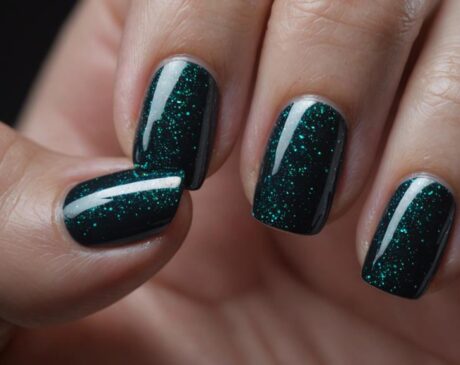Why Do I Have a Nail Growing Under My Nail?
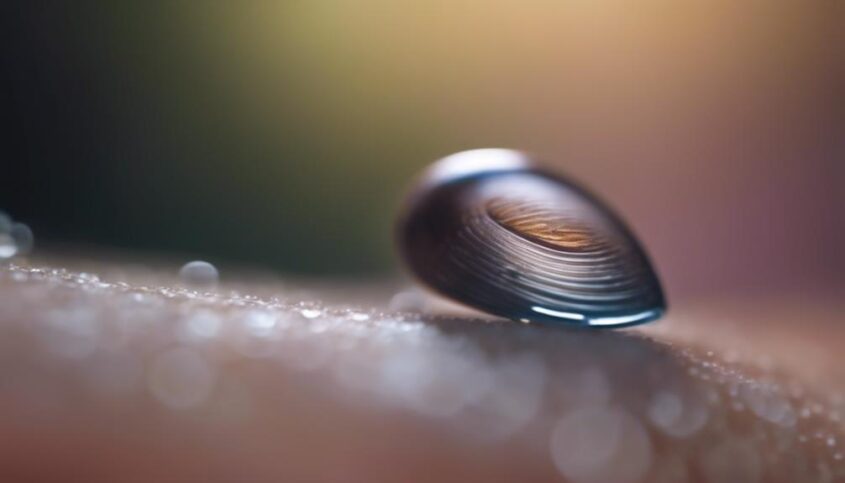
The presence of a nail growing under your nail can stem from causes such as trauma, genetic factors, psoriasis, or fungal infections. Identifying the underlying issue is essential for effective treatment and optimal nail health. Factors like trauma to the nail bed or inherited nail conditions can lead to abnormal nail growth patterns. Nail fungus or infections may also manifest along with discoloration or thickening. Seek guidance from healthcare professionals for proper diagnosis and management. Understanding these factors is crucial in addressing nail abnormalities and promoting healthy nail growth. Further insights await on uncovering the reasons behind nail issues.
Key Takeaways
- Trauma to the nail bed can lead to abnormal nail growth underneath.
- Genetic predisposition may cause nail abnormalities like growth under the nail.
- Medical conditions such as psoriasis or fungal infections can affect nail growth.
- Identifying the underlying cause is essential for proper treatment.
- Consulting a healthcare professional for diagnosis and treatment is crucial.
Possible Causes of Nail Under Nail
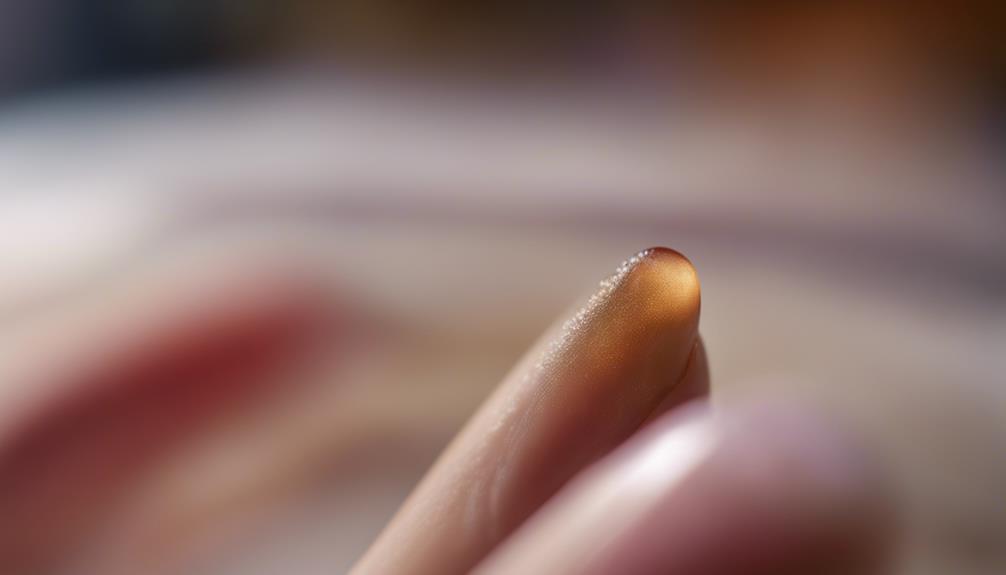
Various factors can lead to the development of a nail growing underneath the nail plate, causing discomfort and aesthetic concerns for individuals experiencing this condition. One common cause is trauma to the nail bed, where the new nail fails to grow in its correct place due to damage. This can happen from injuries such as slamming a finger in a door or repetitive stress on the nail from activities like running. Additionally, a genetic predisposition may play a role in the abnormal growth of nails. Some individuals may have a hereditary trait that causes their nails to grow incorrectly, leading to the development of a nail under the nail plate.
Furthermore, certain medical conditions like psoriasis or lichen planus can affect the nail matrix, the area where the nail begins to form, resulting in abnormal nail growth patterns. In some cases, fungal infections can also distort nail growth, causing a new nail to grow underneath the existing one. Identifying the underlying cause is crucial in determining the appropriate treatment to address the issue and promote healthy nail growth.
Nail Fungus or Infection
Nail fungus or infection can significantly impact the health and appearance of nails, requiring prompt attention and appropriate treatment to prevent further complications. Fungal infections often manifest as discoloration, thickening, or crumbling of the nail. Infections can cause discomfort or pain, and if left untreated, they may spread to other nails or even the surrounding skin. Individuals with weakened immune systems, diabetes, or poor circulation are more susceptible to developing nail fungus or infections.
Treatment for nail fungus or infection may involve topical or oral antifungal medications, removal of the affected nail tissue, or in severe cases, surgical intervention. Maintaining good foot hygiene, wearing breathable footwear, and avoiding walking barefoot in public places can help prevent fungal infections. Regularly trimming nails, keeping them dry, and avoiding sharing nail grooming tools are also essential preventative measures. Seeking guidance from a healthcare professional is crucial for proper diagnosis and management of nail fungus or infection to ensure optimal nail health and appearance.
Trauma or Injury to Nail
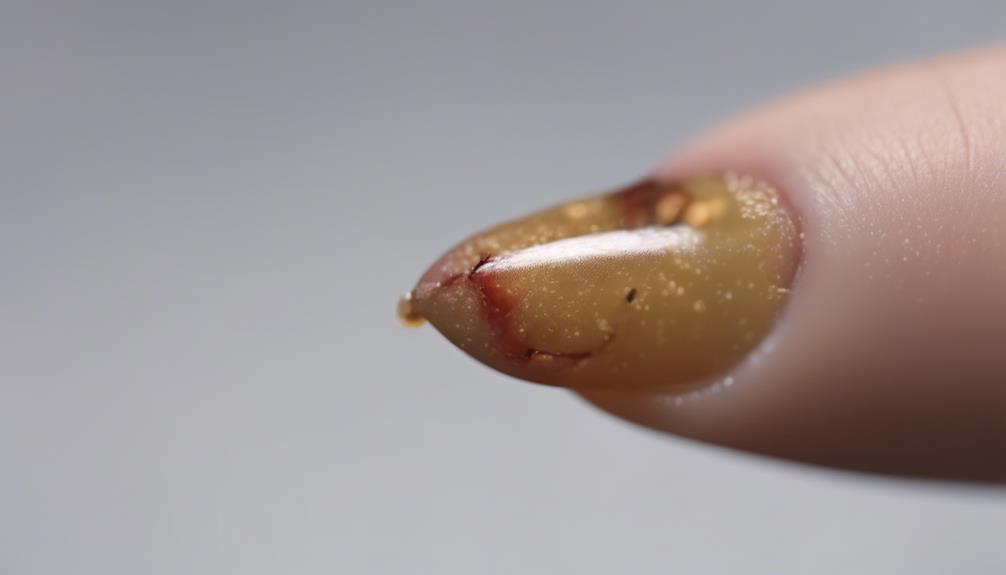
Following an unexpected impact or injury, the nail can be subject to trauma, leading to various complications and potential changes in its growth pattern. Trauma or injury to the nail can result from accidents, repetitive movements, or even vigorous nail grooming practices. These incidents can disrupt the nail matrix, the area where nail growth originates, causing abnormalities in the newly formed nail plate. Here are three ways trauma or injury can affect nail growth:
- Subungual Hematoma: Blood accumulation under the nail due to trauma can cause pain and discoloration.
- Split Nails: Trauma can lead to the development of splits or cracks in the nail plate, affecting its strength and appearance.
- Altered Growth Patterns: Injuries to the nail bed can cause irregular or slow growth, resulting in deformities such as spoon-shaped nails or ridges.
Genetic Factors and Nail Abnormalities
Genetic factors play a significant role in nail abnormalities, often manifesting as inherited nail conditions. Individuals may have a genetic predisposition to certain nail issues, which can be influenced by their family history of abnormalities. Understanding these genetic factors can provide valuable insights into the underlying causes of nail abnormalities and guide appropriate treatment strategies.
Inherited Nail Conditions
Certain hereditary factors play a significant role in the development of nail abnormalities and conditions. These genetic predispositions can lead to various inherited nail conditions. Some common examples include:
- Brittle Nails: Genetic factors can contribute to the tendency for nails to become brittle and prone to breakage.
- Clubbing: Inherited conditions can cause the nails to take on a rounded or clubbed appearance, often indicating an underlying health issue.
- Koilonychia: This condition, where the nails are abnormally thin and concave, can also have genetic links leading to its development.
Understanding these inherited nail conditions can help individuals identify and manage their nail health effectively.
Genetic Predisposition to Nails
In understanding the influence of genetic factors on nail abnormalities, it becomes apparent that inherited nail conditions can be deeply rooted in one's genetic predisposition. Genetic predisposition plays a significant role in determining the health and appearance of nails. Certain genetic factors can make individuals more susceptible to various nail abnormalities such as brittle nails, spoon-shaped nails, or nail ridges. Understanding these genetic predispositions can help individuals take preventive measures and seek appropriate treatments when necessary.
| Genetic Predisposition Factors | Description | Impact on Nails |
|---|---|---|
| Genetics | Family history and genes play a role | Influence nail health |
| Nutrient Absorption | Genetic variations affect nutrient absorption | Can lead to nail abnormalities |
| Hormonal Imbalance | Genetic factors can influence hormonal balance | Affect nail growth and strength |
Family History of Abnormalities
A person's family history can provide valuable insights into the potential genetic factors that may contribute to nail abnormalities. Understanding the presence of certain nail conditions within a family can help individuals and healthcare providers anticipate and manage similar issues effectively. When exploring family history for nail abnormalities, consider the following:
- Inherited Conditions: Some nail abnormalities, such as pincer nails or spoon-shaped nails, can be passed down through generations.
- Genetic Mutations: Certain genetic mutations can lead to nail abnormalities, highlighting the importance of genetic testing for accurate diagnosis.
- Environmental Triggers: While genetic factors play a significant role, environmental factors can also influence the development of nail abnormalities, making a comprehensive assessment essential.
Nail Psoriasis or Other Skin Conditions
Nail psoriasis is a common condition that affects both the nails and the skin, leading to changes in nail health and appearance. Understanding how skin conditions can impact nail growth and structure is crucial in addressing any abnormalities or concerns you may have with your nails. By recognizing the signs and symptoms of nail psoriasis or other skin conditions early on, proper treatment and management strategies can be implemented to promote healthier nails.
Psoriasis and Nail Health
Skin conditions such as psoriasis can have a significant impact on the health and appearance of nails. Psoriasis affecting the nails, also known as nail psoriasis, can manifest in various ways, potentially leading to discomfort and aesthetic concerns. When dealing with psoriasis and nail health, it's essential to consider the following:
- Changes in Nail Color: Psoriasis can cause discoloration of the nails, with affected areas appearing yellowish, reddish, or brownish.
- Pitting and Pitting: Nail psoriasis may result in small dents or pits on the nail surface, affecting its smoothness.
- Separation of the Nail: In severe cases, psoriasis can lead to the separation of the nail from the nail bed, causing pain and potential infection.
Skin Conditions Impact
Skin conditions, especially those affecting the nails like psoriasis, can have a significant impact on overall nail health and appearance. Nail psoriasis, characterized by changes in color, texture, and pitting of the nails, can lead to nail thickening or separation from the nail bed. Other skin conditions like eczema or fungal infections can also affect the nails, causing them to become brittle, discolored, or develop ridges. Proper diagnosis and treatment by a dermatologist are crucial in managing these conditions to prevent further damage to the nails. Maintaining good nail hygiene, keeping nails trimmed, and using moisturizers can help alleviate symptoms associated with these skin conditions. Regular monitoring and seeking medical advice can aid in preserving healthy nails despite underlying skin conditions.
Treatment Options for Nail Growth
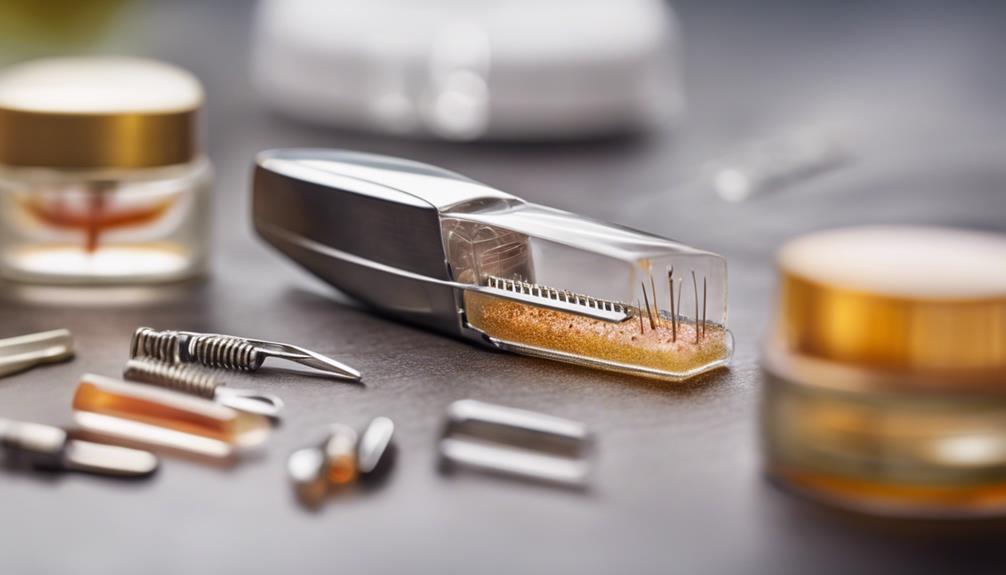
When addressing the issue of nail growth underneath the nail, various treatment options are available to manage and alleviate the condition effectively. These treatments aim to promote nail health and prevent further complications. Here are three key options to consider:
- Proper Nail Care: Maintaining good nail hygiene by keeping nails clean and trimmed can help prevent ingrown nails and promote healthy nail growth.
- Topical Antifungal Medications: If the nail growth is due to a fungal infection, topical antifungal medications can be applied to the affected area to eradicate the infection and promote healthy nail regrowth.
- Professional Medical Intervention: In severe cases where nail growth underneath the nail causes pain, infection, or other complications, seeking help from a healthcare professional, such as a dermatologist or podiatrist, is crucial. They can provide specialized care, such as nail removal or other medical treatments, to address the issue effectively.
Frequently Asked Questions
Can Stress or Anxiety Cause a Nail to Grow Underneath Another Nail?
Stress or anxiety typically do not directly cause a nail to grow underneath another nail. However, stress can impact overall nail health, leading to changes in nail appearance or growth patterns. Consulting a healthcare provider is advised for proper evaluation.
Is It Possible for Nail Biting to Contribute to Nail Growth Abnormalities?
Nail biting can lead to nail growth abnormalities by causing damage to the nail bed. This trauma can result in irregular nail growth patterns, such as ingrown nails or the development of a nail growing underneath another nail.
Are There Any Specific Vitamins or Supplements That Can Help Prevent Nail Abnormalities?
Nail abnormalities can sometimes be prevented or minimized by ensuring adequate intake of vitamins and supplements. Essential nutrients like biotin, vitamin E, and iron can promote healthy nail growth and reduce the risk of issues.
Can Wearing Acrylic Nails or Gel Polish Lead to Nail Growth Issues?
Wearing acrylic nails or gel polish can potentially lead to nail growth issues such as thinning, brittleness, or discoloration due to the chemicals and techniques involved. Proper care, maintenance, and breaks between applications can mitigate these risks.
Is There a Connection Between Hormonal Changes and Nail Growth Abnormalities?
Hormonal changes can indeed lead to nail growth abnormalities. Fluctuations in hormones, such as during pregnancy or menopause, can impact the rate and quality of nail growth. Consulting a healthcare provider for proper diagnosis and management is recommended.



